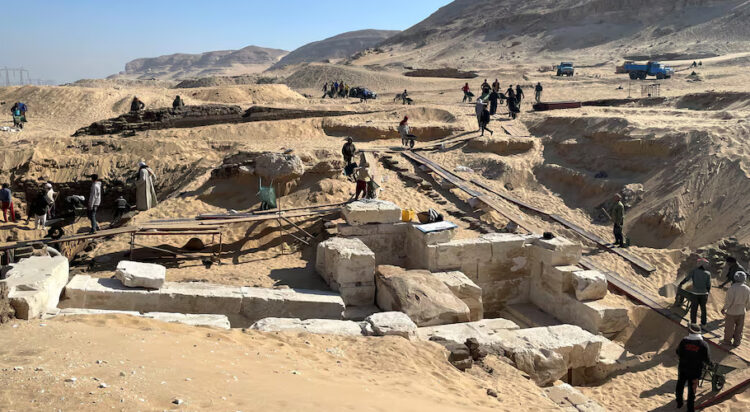Archaeologists have discovered the large limestone burial chamber of an unidentified ancient Egyptian pharaoh near the city of Abydos dating to about 3,600 years ago during a chaotic period in Egypt’s history.
The discovery of the tomb seven meters (23 feet) underground at the ancient necropolis of Anubis Mountain was announced by University of Pennsylvania Museum and Egyptian archaeologists. It marked the second discovery announced this year of a tomb of an ancient Egyptian king.
Make sense of the latest ESG trends affecting companies and governments with the Reuters Sustainable Switch newsletter. Sign up here.
The burial chamber discovered in January at Abydos, an important city in ancient Egypt located about 10 km (6 miles) from the Nile River, was bare – apparently long ago plundered by grave robbers. The name of the king once buried inside was originally recorded in hieroglyphic texts on plastered brickwork at the chamber’s entrance alongside painted scenes showing the sister goddesses Isis and Nephthys.
“His name was in the inscriptions but does not survive the depredations of ancient tomb robbers. Some candidates include kings named Senaiib and Paentjeni who we know from monuments at Abydos – they ruled in this era – but whose tombs have not been found,” University of Pennsylvania Egyptian archaeology professor Josef Wegner, one of the leaders of the excavation work, said on Thursday.
In addition to the decorated entryway, the burial chamber featured a series of other rooms capped by five-meter (16-foot) high vaults fashioned from mudbrick.
The tomb dates to a time known as the Second Intermediate Period that ran from 1640 BC to 1540 BC and bridged the Middle Kingdom and New Kingdom eras when Egyptian pharaohs were among the most powerful figures in the region.

“The political history of the era is fascinating and not fully understood, a kind of ‘warring states’ period that ultimately gave birth to Egypt’s New Kingdom,” said Wegner, curator of the Penn museum’s Egyptian section.
Among these was the Abydos Dynasty, which was a series of kings who ruled part of Upper Egypt – the southern portion of the Egyptian realm.

“Egypt was fragmented with as many as four rival kingdoms, including the Hyksos of the Nile Delta,” said Wegner. “The Abydos Dynasty was one of these. How it broke apart and then was reunified includes important questions of social, political and technological change.”
The tomb of the unidentified king is built inside the larger tomb complex of an earlier and powerful pharaoh named Neferhotep I. Its architecture shows connections with earlier Middle Kingdom and later Second Intermediate Period royal tombs, Wegner said.
“It seems to be the largest and earliest of the Abydos Dynasty group. There may be others in this same area next to the tomb of Neferhotep I,” Wegner said.
Wegner’s team previously uncovered the tomb of another Abydos Dynasty ruler named Seneb-Kay in 2014.




































